1905 Ten Dollars National Currency Note
This is a 1905 series Ten Dollar National Currency Banknote. This particular note was issued by the Milford National Bank in Milford, Massachusetts. This note is of the Large Size variety which was issued prior to 1928. Back then, banks which wanted to issue their own banknotes could do so by becoming a National Bank. To do so required the bank to put up bonds with the U.S. Treasury, and have a minimum amount of capital in their bank. In the beginning National Banks were limited to issuing notes up to 90% of their Bonds. This rule was eased as time went on and by the time this note was issued, the banks had the requirement of having a capital ratio of at least $25,000 for a community up to 3,000 people. The banks were also allowed to issue funds up to the full amount of their funds on deposit with the U.S. Treasury.
This note has some distinctive features including a portrait of William McKinley, the 25th President of the United States, placed at the far left in a porthole type frame. The blue seal and serial numbers, later designated solely for Silver Certificates, was then in vogue for other notes as well. The larger numbers with the letter are known as a Charter Number assigned by the government to the National Bank.
The reverse of this note has a central vignette depicting Liberty/Union in the middle with two ships on either side. The oddest thing to strike most people is the two dates: 1902 and 1908 on either side of Liberty. The notes with these dates are commonly referred to as “Date Backs’, and are a representation of the inclusive dates of the intended issuance granted for these notes by the Treasury. After 1908, these notes were originally supposed to end their service. But there are notes without these dates (called Plain Backs), which were issued after 1908 due to the need for the notes in the economy at the time.

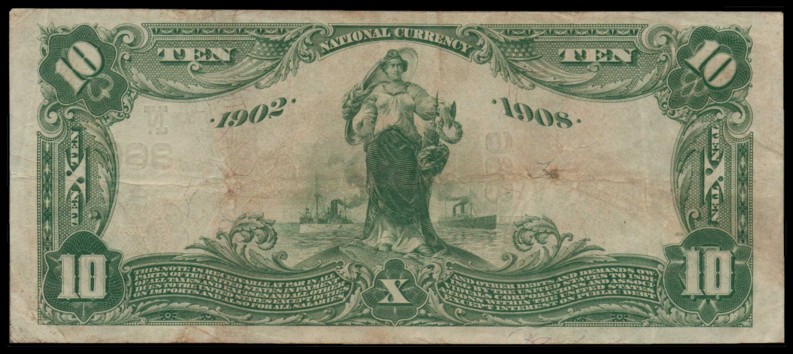
1914 Ten Dollars Federal Reserve Note
Here is a rather nice large-sized $10 Federal Reserve Note that was issued in 1914. This was before the Federal Reserve adopted the green seals we are used to seeing today. When this note was issued World War One (known then as the Great War) began and lasted four devastating years. Meanwhile, Pancho Villa was riding the wave of revolution in Mexico. In 1914 Ford Motor Company introduced the eight-hour work day and, even though Federal Minimum Wage laws weren’t enacted until 1938, Ford set their minimum wage at $5 a day. This banknote was worth Two-days of minimum wage labor. It would cost five – cents to see the new movie ‘Making a Living’ in which Charlie Chaplin made his debut in silent film. The reverse of this note is interesting as it’s vignette depicts allegorical representations of Agriculture and Industry in what was then common form. Note the four horses and three men instead of one tractor and one man in the wheat field, and the many smokestacks in the factory darkening the sky. These images bring to mind how much the United States, and the world, has changed since then. This $10 FRN has a design similar in composition to the 1914 $5 FRN above, which stayed common until the major redesign and resizing that took place in 1928.


1922 Ten Dollars Gold Certificate
Most us us have known that there were Silver Certificates, but we also had Gold certificates as well. These notes were backed by gold just as the silver certificates were backed by silver. Authorized back in 1865, Gold Certificates weren’t issued to the general public at first, and were used only in fiscal transactions between banks and other fiscal organizations. In 1907 they were released for general public use and were used just like any other banknote. The last large size issue was series 1922. These issues were very distinctive, as they were not only large, but the reverse images were all printed in a bright orange color, which is carried onto the front with the seals and serial numbers.
Gold certificates were subject to the Gold Reserve Act of 1934 which required all U.S. citizens to turn in their gold, as well as their gold certificates, to the treasury, which exchanged the gold and the certificates for other types of currency. While the large sized notes were by then gone from circulation, they were not allowed to be owned by the public. In 1964 they were let back into the public hands, albeit without the gold backing. Combined with their being fewer in number, their long absence helped to make them less well known to most of the general public.
This is a 1922 Large Sized 10 dollar Gold Certificate. The portrait is of Michael Hillegas, the first U.S. Treasurer. Actually, he held the offices of the Treasurer of the United Colonies (1775), later changed to the Treasurer of the United States(1778). When congress created the Treasury Department in 1789, Alexander Hamilton was appointed the Treasury Secretary, and Hillegas resigned his position of Treasurer and Samuel Meredith was appointed to the position of Treasurer.
The Redemption Clause reads: “This certificate is a legal tender in the amount thereof in payment of all debts and dues Public and private. Acts of March 14, 1900, as amended and December 24, 1919.”


1928 Ten Dollars Gold Certificate
When the currency was redesigned and resized in 1928, the gold certificates suffered the loss of their bright reverse image, but retained the color for the serial number and the seal. The references to these 1928 Gold Certificates is made only on the front. The reverses of these notes are identical in design to the Federal Reserve Notes.
The series 1928 small sized gold certificate shown above was rather short lived, as it was subject to the Gold Reserve Act of 1934 which stated that all United States citizens were required to turn in their gold as well as their gold certificates to the treasury, which exchanged the gold and the certificates for other types of currency. Exceptions were made for some jewelry and collector coins. Wisely, not everyone did so, and we have a large number of these notes to collect, though they are rather expensive, especially in uncirculated conditions. The gold certificates were released back to the public again in 1964 and are still considered legal tender, but their redemption clause was rendered invalid just like the silver certificates. It sounds strange now, but it was a criminal offense for US citizens to have or trade gold until 1975.


1928 Ten Dollars FRN “Numerical District”
Here’s a 1928 Federal Reserve 10 Dollar note. The Treasury Seal on the right is green like our modern notes, and the Federal Reserve seal has a number instead of a letter. Commonly called “Numbered Districts” or “Numerical Notes”, the district numbers were printed on the 1928 and 1928A series of notes only. With 1928B series they went to the lettered designation, so this number, 4, would later become D which is, as written on the bottom of the seal, the Cleveland, Ohio branch of the Federal Reserve Bank.

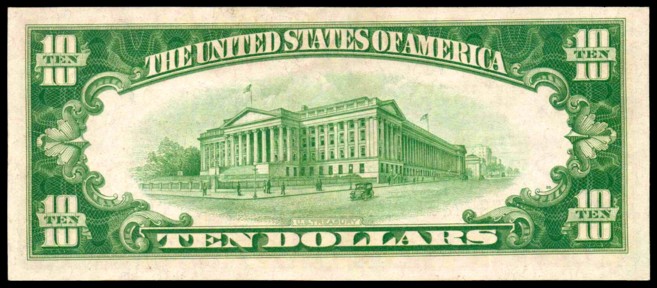
1928B Federal Reserve Note
First glance at this and it’s likely you’d miss the change in design. This note, a 1928-B issue, has a new style of the Federal Reserve Seal, changing from the numbered designator, to the lettered designator. This one was issued for the Chicago branch, and is letter ‘G’, which is the 7th letter in the alphabet, and thus has the four small black number 7’s on the face.


1929 Ten Dollars F R B N
This is a 1929 $10 Federal Reserve Bank-Note. a quick comparison to the previous note will show that the Treasury Seal on the right is Brown to differentiate from the FRN’s, and the Federal Reserve seal is missing altogether, replaced by four bold letters for the district and text stating they are from the Federal Reserve Bank (and in this case) of Cleveland, Ohio.
The reason for these notes was that in the first months of 1933, there was a heavy withdrawal from the Federal Reserve in part due to people holding onto their money personally because many banks were failing. National Banks could not issue more currency, due to limitations based on their holdings to issued notes ratio. This resulted in a shortage of available Federal Reserve banknotes for the public. So on March 09, 1933 Federal Reserve Banknotes (FRBN’s) were authorized as an emergency currency to be issued to overcome this shortage of cash.
These emergency notes were printed on unused National Banknotes. There are some obvious differences though, including the overstamp of the bank and location, which was replaced by the Federal Reserve Bank for the district. Instead of leaving the two bottom signatures blank, they Federal Reserve Bank officers signed there (note the two blacked out National Bank titles replaced with appropriate Federal Reserve Bank titles). Similar to the National Banknotes, these Federal Reserve Banknotes were backed by the Federal Reserve Bank, but with an important distinction. While National Banknotes were backed by bonds from the National Banks, these FRBN’s had the added clause of “Or Like Deposit Of Other Securities” added to conform to actual backing practices for these notes. The Charter Numbers were replaced by the letter designation for the Federal Reserve Bank Branch (A=1=Boston, 8=H=St. Louis, etc.). After two years in service, these notes were removed from circulation by the banks.
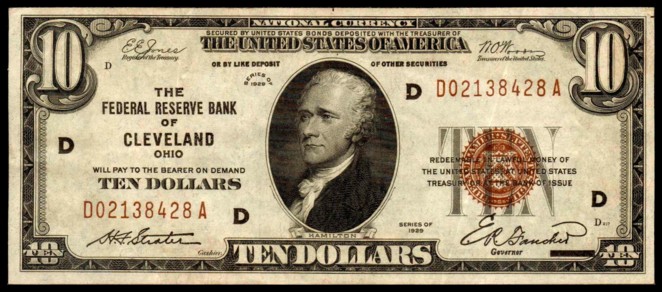

1929 Ten Dollars National Bank Note “New York” Type 1
National Currency also underwent a design change as well as a resizing after 1928. The note shown here is a 1929 National Currency note, issued by the “Public National Bank and Trust Company of New York.” In 1955 this bank was absorbed into the Bankers trust Company, and is now park of Deutsche Bank. This is a Type I note, having the charter number printed only in black on the note, which was issued from 1929 through 1933. Type II also had the charter number printed in brown like the serial number was, and were issued throguh 1935. National Banknotes were ended in 1935 when the governmnet called in all the bonds which secured the funds which backed these notes.
This is a ‘Type 1’ note, identifiable by the National Bank Charter Number being printed on the front of the note twice, on the left and right sides, in bold numbers. See ‘Type 2’ below.

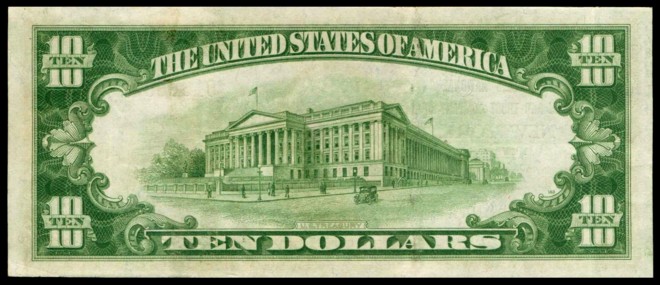
1929 Ten Dollars National Bank Note “Columbus” Type 2
National Currency also underwent a design change as well as a resizing after 1928. The note shown here is a 1929 National Currency note, issued by the “Public National Bank and Trust Company of New York.” In 1955 this bank was absorbed into the Bankers trust Company, and is now park of Deutsche Bank. This is a Type I note, having the charter number printed only in black on the note, which was issued from 1929 through 1933. Type II also had the charter number printed in brown like the serial number was, and were issued through 1935. National Banknotes were ended in 1935 when the government called in all the bonds which secured the funds which backed these notes.
This is a ‘Type 2’ note, identifiable by the National Bank Charter Number being printed two times in bold on the left and right sides, as well as being printed two additional times in brown ink adjacent to the serial numbers. See ‘Type 1’ above.

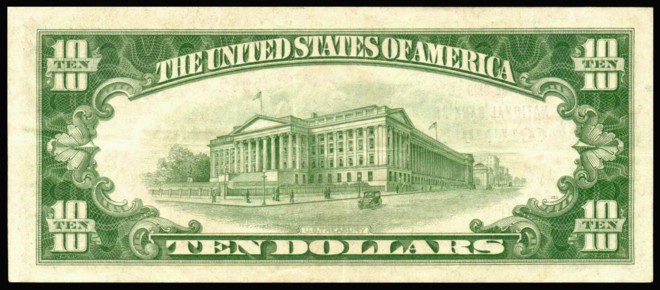
1934C Ten Dollars Silver Certificate
As with all the other notes, the 10 dollar Silver Certificates were resized to their present dimensions. The note shown here is a 1934 C Series note. I can remember getting these in change and in cards as presents when I was a kid in the 1970’s and 1980’s, but even though I tried taking them to the coin shops to see how valuable they were, the coin shops no interest in them, so I spent them (usually on candy and such). This one I had to buy; sure wish I kept them instead. It has the modern redemption clause we use today.


1934 Ten Dollars Federal Reserve Note
Here is a 1934 $10 Federal Reserve Note, small size. While this looks much more familiar to us, you will notice that the seal and serial numbers are pale, lime green color. The greens actually come in Dark Green, Lime (or light) Green and normal green. Depending on how the inks were mixed and how many were printed with that color, some notes can command a premium for collectors.


1934A Ten Dollars Federal Reserve Note “Hawaii”
In Hawaii, it was thought that the Japanese might try to invade the Hawaiian Islands, and as a precautionary measure, the government issued notes specifically for this island chain. Federal Reserve notes were stamped with HAWAII on the left and right of the fronts and a larger stamp on the reverse (the One Dollar bill was a Silver Certificate, as no $1 FRN’s were printed at that time). As a further precautionary measure, the Treasury seal and serial numbers of the notes were colored brown. If the Japanese had invaded Hawaii, the US Government would have been able to easily decree that the Hawaii stamped notes were no longer Legal Tender. These notes were brought home and are still legal tender today, as all government notes are.


1934A Ten Dollars Silver Certificate “North Africa”
The note above is a 1934A 10 Dollar Silver Certificate which was issued for military use in North Africa during WWII. The yellow seal and serial numbers were used as a precautionary measure to ensure that if the Axis were to obtain a large amount of these notes in battle, the U.S. could easily declare these notes invalid and keep them from being used by the enemy. These notes were brought home and are still legal tender today, as all government notes are.
The 10 Dollar Silver Certificate was the highest denomination issued for use in North Africa.


1934A Ten Dollars Federal Reserve Note
This note is a 1934A Federal Reserve Note. You can easily see the difference between this regular issue and those special issued for Hawaii and North Africa.
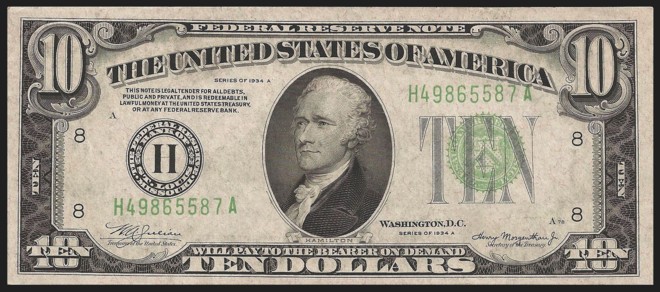
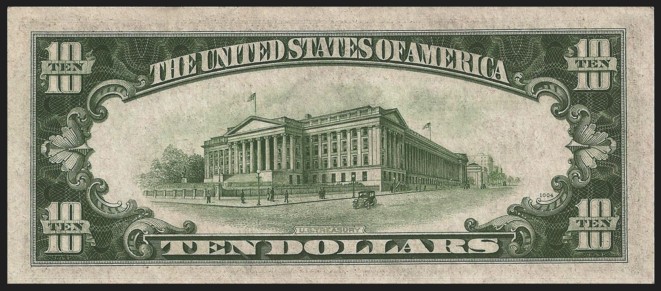
1950A Ten Dollars FRN
This note is a 1950A series. Design changes in 1950 included making things smaller, including the FRN seal and Treasury seal, along with the TEN over the Treasury seal. The redemption clause is the same, but the sentences were made slightly longer to reduce it from four lines to three, and teh date at the top left of the portrait was removed. “Washington D.C.” was also removed from above the date at the bototm.The number placement of the four black numerical Federal Reserve Bank indicators have also moved in slightly. The back of the note, however is still the same.


1953 Ten Dollars Silver Certificate
This note is a 1953 Silver Certificate. The main changes from the 1934 SC issue were in the numeral color at left and the smaller size of the treasury seal on the right.


1963A Ten Dollars FRN
In 1963 changes in were more modest in appearance, but very important. Let’s start with the redemption clause. It now says only “Legal Tender For All Debts, Public and Private’. There is no mention of redeeming this banknote for ‘lawful money’, and at the bottom center, there above the TEN DOLLARS, you will no longer find the phrase “Will pay to the bearer on demand”. As if adding a prayer to this new clause’s acceptance, the motto “In God We Trust” was added to the back, above the U.S. Treasury building.

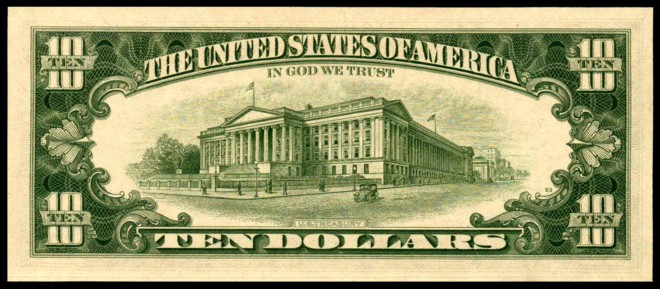
1981 Federal Reserve Note
In 1969 there was a sleight design change, which is represented in this 1981 FRN. At first glance, it has little change from the previous issue, but if you look close, you will see that the Treasury Seal had a change from Latin to English and reads “The Department of the Treasury – 1790”.


1999 Ten Dollar Federal Reserve Note “Big Head”
Above is an example of the larger portrait 10 dollar note issued in 1999, and is a “Big Head” design. The new design was done to combat counterfeiting and incorporated a watermark, new security thread and microprint, and color changing ink. This particular note is also called a ‘Star Note’ due to the star at the ends of the serial numbers. The star is a designation that the individual note was issued as a replacement for a note that was not issued due to printing errors or other notes that were destroyed by the Bureau of Engraving and Printing because they were damaged, too worn, etc.


2004A Ten Dollar Federal Reserve Note “Colorized”
Here’s the colorized 10 dollar banknote that followed the big head issue above. The EURion pattern is disguised in the pattern of yellow 10’s that are on the front left and again on the right reverse.

